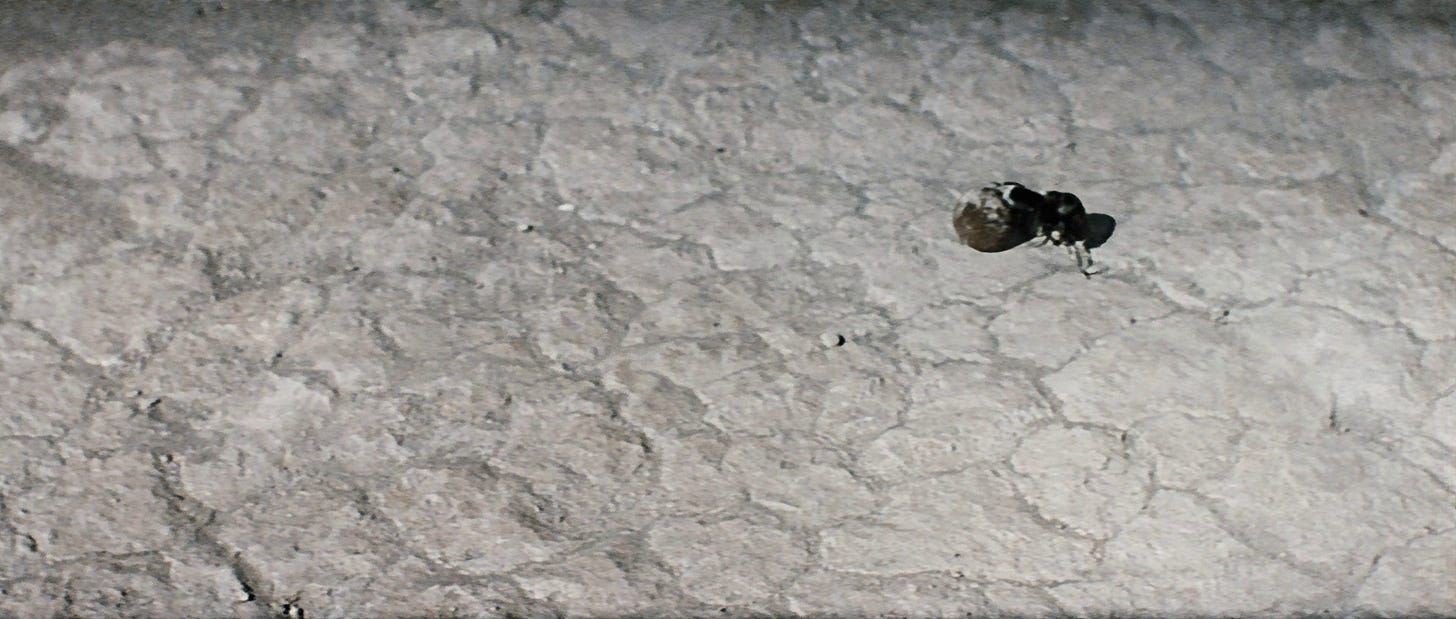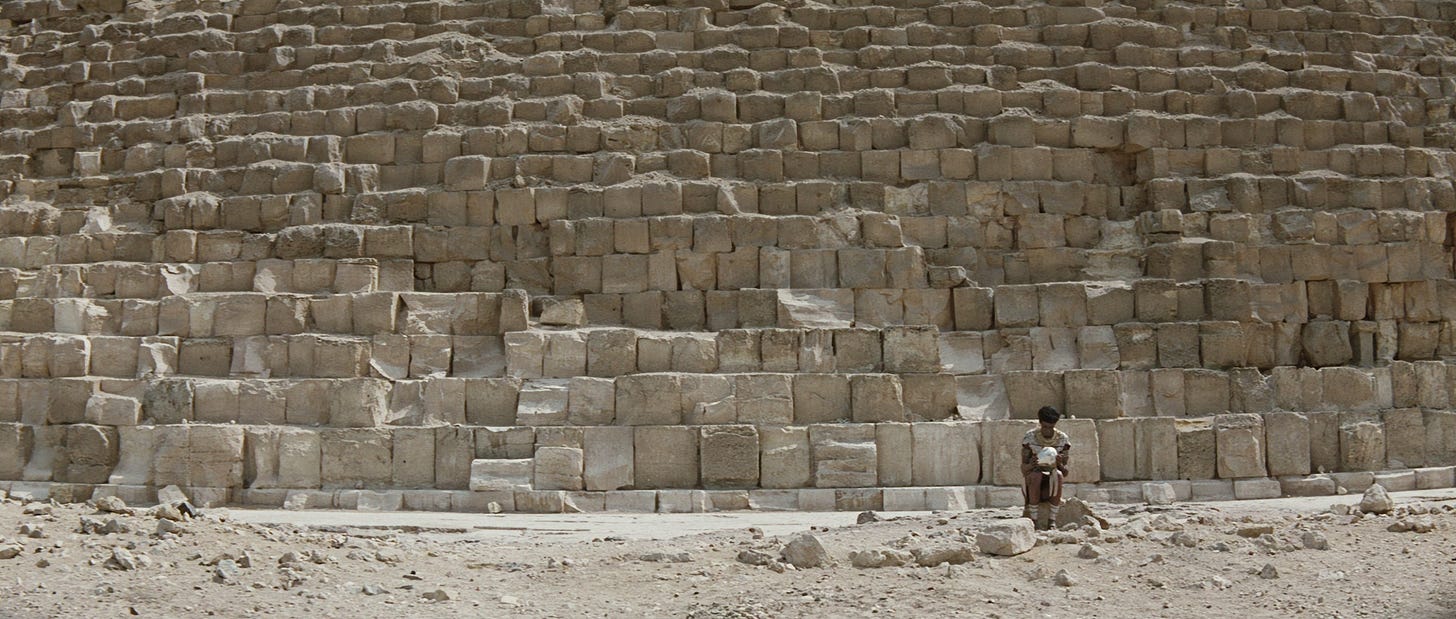The Ancient Tomb
On the film Pharaoh (Jerzy Kawalerowicz, 1966).
Pharaoh initiates us into its world with an image of insect labor: two beetles grappling, rolling a ball of dung across bleached, arid ground. There is a man who has been watching the beetles, lying prostrate. He rises, and we watch him turn and begin to jog, with some urgency, back through row upon row of troops standing on a desert road. The camera stays just ahead of him as he jogs, tracking backwards, concealing both his destination and the distance still to be covered. The shot lasts for a long time; well before it ends, the actor has begun to show visible fatigue, and we have entirely lost count of how many rows of troops he has passed. Finally, he arrives before his masters, Prince Ramses XIII and the High Priest Herhor. He immediately prostrates himself as he had before the beetles. Commanded to speak, he reports what he has seen, the two beetles rolling the dungball across the road, and that it is for this reason the troops have been halted. Herhor approves: the beetles are sacred, there can be no risk of them being crushed beneath a soldier’s heel. He orders that the entire column be rerouted down an alternate path, a gorge which will take them a mile out of the way. The Prince complains, but it is done – an entire army is diverted out of deference to the beetles. To do this, they have to fill in a canal which a single slave has spent most of his life digging, having been promised freedom upon its completion. An old man now, he begs and pleads with them not to, but once again, it is done. Upon the army’s return, victorious, they find that he’s hanged himself. In this situation, the Prince and the slave were equally powerless. But in the face of what authority – the beetle, or the Priest? In this question can be found Pharaoh’s entire drama in microcosm.
This is a film whose existence I find miraculously strange. It is an epic of ancient Egypt, possessing a scale and ambition comparable to the most spectacular Hollywood historical epics of the ’Scope era, but produced in Poland in the mid-60s, shot across three continents, with an all-Polish cast done up in various amounts of bronzer, all speaking Polish. Of course, it isn’t any more ahistorical to have a man in a nemes speaking Polish than to have him speaking English, but for someone familiar only with the aforementioned ‘Scope epics, it is the first sign that, despite certain superficial similarities, it is operating under a fundamentally different paradigm. There is nudity, for one thing, and explicit sexual references; more importantly, it is deeply morally ambiguous. This is a film about a power struggle in which all the relevant actors demonstrate both a capacity for unapologetic cruelty, befitting a villain, and a concern for something greater than self-interest, befitting a hero. Really, it makes no sense to speak of the characters in those terms – the film certainly doesn’t want you to. Its gaze is dispassionate, observational; the subject here is a mechanism, a social structure in a period of transition – judgement is beside the point. It is a film of long takes, deliberate pacing, figures isolated in harsh, spartan environments. It’s an epic which is as akin to Antonioni as it is to DeMille – the fact that such a thing exists, that such bizarre, dissonant combination of forms was ever brought together at this great scale, at this lavish expense, is utterly delightful to me. This is a sober-minded film, certainly, but there were times watching it when I could almost have clapped my hands with glee at the sheer audacity of the undertaking I was witnessing.
Like most sober-minded films produced by Eastern Bloc countries which reached international markets, Pharaoh is usually read by Western critics as being a commentary on the Soviet government, authoritarianism, et cetera, et cetera, you know how it goes – and yes, sure, to some extent this is clearly the case. All films about “matters of state” are always, on some level, about the matters of the state in which it was produced. But what I find fascinating about this film is not the ways in which its drama is analogous to those of then-contemporary politics, but the ways in which it is emphatically not. Pharaoh takes more seriously than any other film I’m aware of the reality of Dynastic Egypt as a period of history which was truly, radically different from our own. Wikipedia tells me that a Professor Kazimierz Michałowski, a “world authority in Egyptology”, consulted on the film, so we can reasonably assume its depiction bears some meaningful relation to historical fact, or, at least, historical educated-guess, but it doesn’t really matter – accurate or not, the film feels not like history so much as science fiction, the kind set in a future so distant that our own time has been all but erased from history’s ledger. Gene Wolfe’s work, in particular, came to mind more than once, not a common experience for me while watching films set a thousand years before the birth of Christ.
Although the film’s outdoor scenes were mostly shot in the Kyzyl Kum desert of Uzbekistan (and its interiors in a studio in Łódź), certain sequences were, as a matter of necessity, actually shot in Egypt, most notably a conversation between the young Ramses and Pentuer, Herhor’s assistant, which is staged before the tomb of the pharaoh Khufu, a structure more commonly known, today, as the Great Pyramid of Giza. Ramses sees this tomb as a monument to Khufu’s will, his power, and laments that the state he has inherited lacks the wealth or the labor power with which he might equal it. Previously in the film, Pentuer has shown himself to be more sympathetic to Ramses than Herhor and the rest of the priesthood, and here we learn why: after observing that half a million died constructing the pyramid, he reveals that he came “from the people,” and believes that he might save them “from their misery.” What is important here is not so much the particulars of this conversation, but that the pyramid itself, the real, actual, physical product of all that suffering and death, is positioned in the background for its entirety. Because it is the real thing, not a set or a model or a painted backdrop but the actual, 4,500-year-old structure, it looks old, incredibly, incredibly old – and one realizes, with a start, that yes, this is, in fact, how it should look, because in the 1080s BCE, when the film is set, the Great Pyramid was already ancient. This, I think, is the key to the film, to its cold, eerie power – it is about a society unfathomably historically distant from our own which itself exists in the (literal!) shadow of millennia of history. This historical vertigo lurks in the background of every film about the “ancient world,” of course, but here it is brought to the forefront in a way commercial films rarely dare to, in a way I certainly have not seen from any other production of its scale, the weight of time bearing down upon the images like the ocean upon a sunken ship. There is a certain degree of commonality here with what Straub/Huillet would later do in, say, Othon or History Lessons, but those films are about the Modern as much as they are about the Ancient – they stage a dialectical encounter; Pharaoh does not. Pharaoh is a film in which there is no Modern, not even a Present, only the past and the deeper past, layer upon layer, cardinalities of infinity, everything receding into the distance, swallowed up by the depths. In the one sequence of the film where “the people” could be said to feature significantly, we see them from high above, running and cowering like mice in total, abject terror. This comes shortly before the final image of the film, a slow tracking shot into the darkness of a doorway in which the pharaoh is expected to appear, but will not. I have stated already I find the film more interesting for the ways in which it is not about the politics of its time than the ways that it is – but I do think it’s notable that the book upon which it is based was reportedly a favorite of Joseph Stalin.



